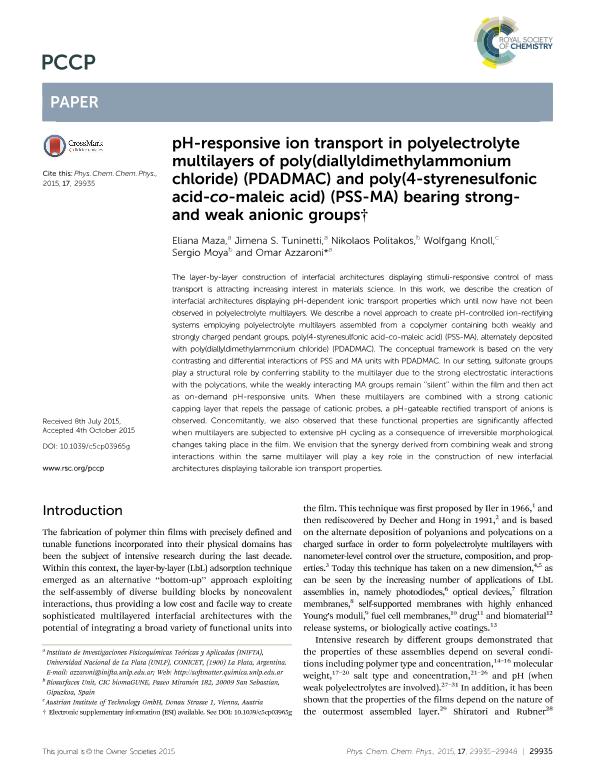Mostrar el registro sencillo del ítem
dc.contributor.author
Maza, Eliana María

dc.contributor.author
Tuninetti, Jimena Soledad

dc.contributor.author
Politakos, Nikolaos
dc.contributor.author
Knoll, Wolfgang
dc.contributor.author
Moya, Sergio Eduardo

dc.contributor.author
Azzaroni, Omar

dc.date.available
2018-06-18T17:10:21Z
dc.date.issued
2015-10
dc.identifier.citation
Maza, Eliana María; Tuninetti, Jimena Soledad; Politakos, Nikolaos; Knoll, Wolfgang; Moya, Sergio Eduardo; et al.; PH-responsive ion transport in polyelectrolyte multilayers of poly(diallyldimethylammonium chloride) (PDADMAC) and poly(4-styrenesulfonic acid-co-maleic acid) (PSS-MA) bearing strong- and weak anionic groups; Royal Society of Chemistry; Physical Chemistry Chemical Physics; 17; 44; 10-2015; 29935-29948
dc.identifier.issn
1463-9076
dc.identifier.uri
http://hdl.handle.net/11336/49012
dc.description.abstract
The layer-by-layer construction of interfacial architectures displaying stimuli-responsive control of mass transport is attracting increasing interest in materials science. In this work, we describe the creation of interfacial architectures displaying pH-dependent ionic transport properties which until now have not been observed in polyelectrolyte multilayers. We describe a novel approach to create pH-controlled ion-rectifying systems employing polyelectrolyte multilayers assembled from a copolymer containing both weakly and strongly charged pendant groups, poly(4-styrenesulfonic acid-co-maleic acid) (PSS-MA), alternately deposited with poly(diallyldimethylammonium chloride) (PDADMAC). The conceptual framework is based on the very contrasting and differential interactions of PSS and MA units with PDADMAC. In our setting, sulfonate groups play a structural role by conferring stability to the multilayer due to the strong electrostatic interactions with the polycations, while the weakly interacting MA groups remain "silent" within the film and then act as on-demand pH-responsive units. When these multilayers are combined with a strong cationic capping layer that repels the passage of cationic probes, a pH-gateable rectified transport of anions is observed. Concomitantly, we also observed that these functional properties are significantly affected when multilayers are subjected to extensive pH cycling as a consequence of irreversible morphological changes taking place in the film. We envision that the synergy derived from combining weak and strong interactions within the same multilayer will play a key role in the construction of new interfacial architectures displaying tailorable ion transport properties.
dc.format
application/pdf
dc.language.iso
eng
dc.publisher
Royal Society of Chemistry

dc.rights
info:eu-repo/semantics/openAccess
dc.rights.uri
https://creativecommons.org/licenses/by-nc-sa/2.5/ar/
dc.subject
Multilayers
dc.subject
Polyelectrolyte
dc.subject.classification
Otras Ciencias Químicas

dc.subject.classification
Ciencias Químicas

dc.subject.classification
CIENCIAS NATURALES Y EXACTAS

dc.title
PH-responsive ion transport in polyelectrolyte multilayers of poly(diallyldimethylammonium chloride) (PDADMAC) and poly(4-styrenesulfonic acid-co-maleic acid) (PSS-MA) bearing strong- and weak anionic groups
dc.type
info:eu-repo/semantics/article
dc.type
info:ar-repo/semantics/artículo
dc.type
info:eu-repo/semantics/publishedVersion
dc.date.updated
2018-06-14T19:04:59Z
dc.journal.volume
17
dc.journal.number
44
dc.journal.pagination
29935-29948
dc.journal.pais
Reino Unido

dc.journal.ciudad
Cambridge
dc.description.fil
Fil: Maza, Eliana María. Consejo Nacional de Investigaciones Científicas y Técnicas. Centro Científico Tecnológico Conicet - La Plata. Instituto de Investigaciones Fisicoquímicas Teóricas y Aplicadas. Universidad Nacional de La Plata. Facultad de Ciencias Exactas. Instituto de Investigaciones Fisicoquímicas Teóricas y Aplicadas; Argentina
dc.description.fil
Fil: Tuninetti, Jimena Soledad. Consejo Nacional de Investigaciones Científicas y Técnicas. Centro Científico Tecnológico Conicet - La Plata. Instituto de Investigaciones Fisicoquímicas Teóricas y Aplicadas. Universidad Nacional de La Plata. Facultad de Ciencias Exactas. Instituto de Investigaciones Fisicoquímicas Teóricas y Aplicadas; Argentina
dc.description.fil
Fil: Politakos, Nikolaos. CIC biomaGUNE. Biosurfaces Unit; España
dc.description.fil
Fil: Knoll, Wolfgang. Austrian Institute of Technology; Austria
dc.description.fil
Fil: Moya, Sergio Eduardo. CIC biomaGUNE. Biosurfaces Unit; España
dc.description.fil
Fil: Azzaroni, Omar. Consejo Nacional de Investigaciones Científicas y Técnicas. Centro Científico Tecnológico Conicet - La Plata. Instituto de Investigaciones Fisicoquímicas Teóricas y Aplicadas. Universidad Nacional de La Plata. Facultad de Ciencias Exactas. Instituto de Investigaciones Fisicoquímicas Teóricas y Aplicadas; Argentina
dc.journal.title
Physical Chemistry Chemical Physics

dc.relation.alternativeid
info:eu-repo/semantics/altIdentifier/doi/http://dx.doi.org/10.1039/c5cp03965g
dc.relation.alternativeid
info:eu-repo/semantics/altIdentifier/url/http://pubs.rsc.org/en/Content/ArticleLanding/2015/CP/C5CP03965G#!divAbstract
Archivos asociados
